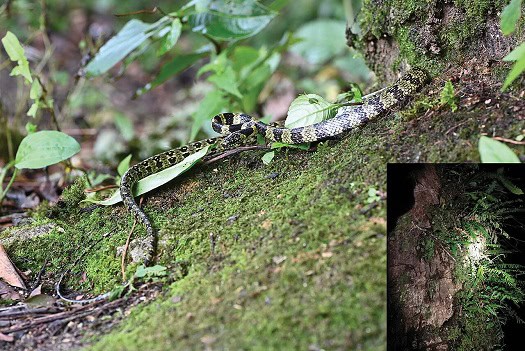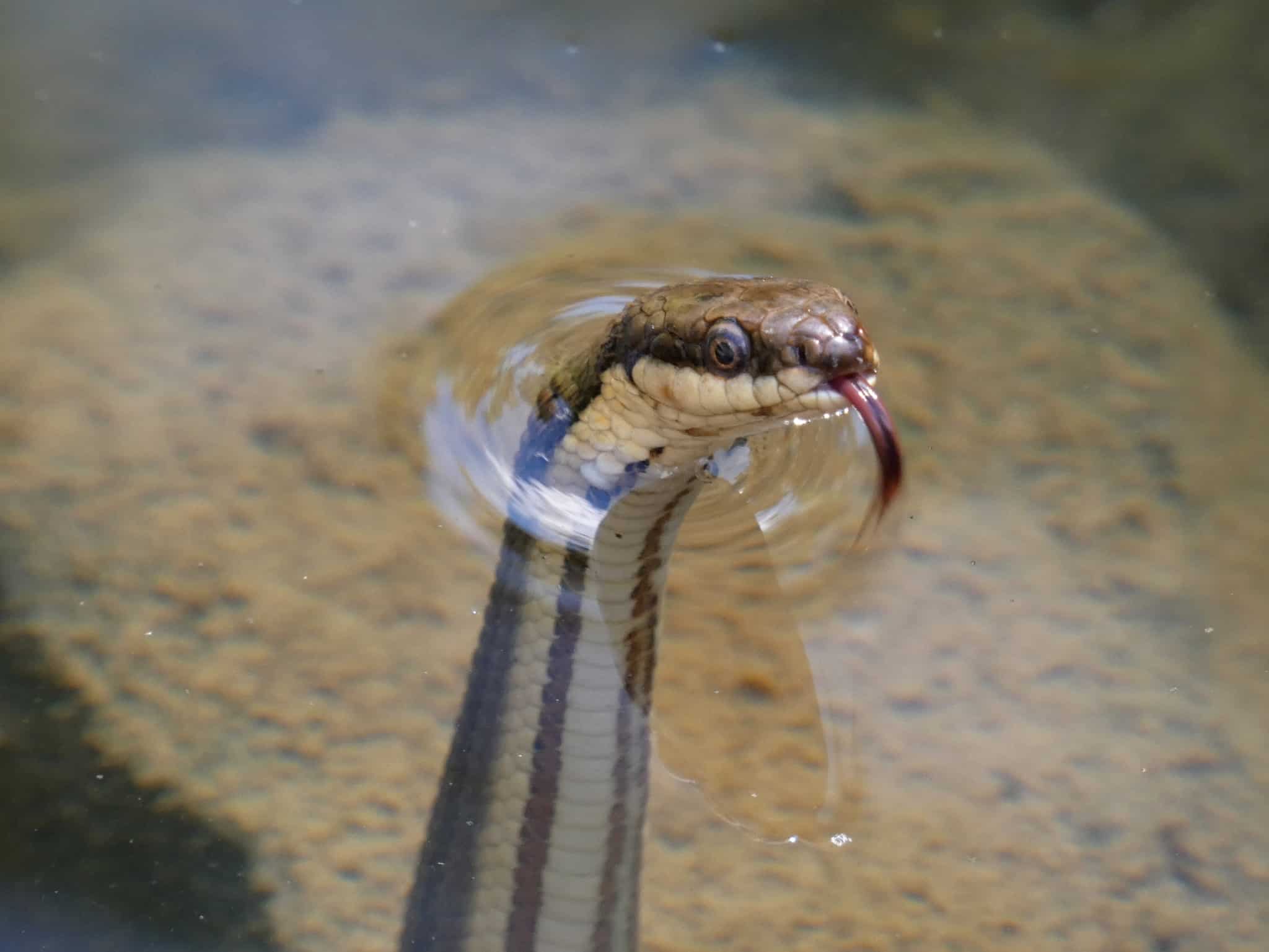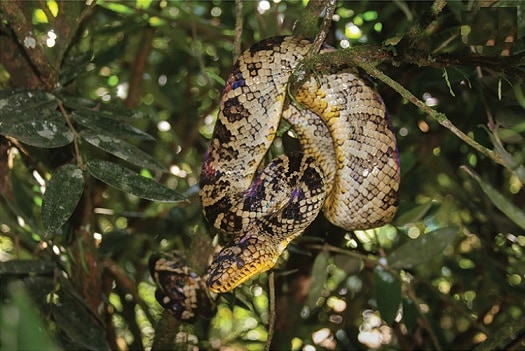| 1 | Gammie’s wolf snake |

This east Asian snake was first discovered in 1878, but not seen again for nearly 130 years. Gammie’s wolf snake (Lycodon gammiei) belongs to the giant Lycodon wolf snake family, which currently has 73 members. It took until 2007 for scientists to find a new batch of the snake in West Bengal, India. By 2023, just 10 specimens of the snake were known.
That year, scientists found a new snake in China which extended its range to the east. The new snake was found on a tree near a road in Medog County, southeastern Xizang, China, at an elevation of 1413 metres. It had a length of just over 80cm, and they somehow discovered it at 23:30, using keen eyesight.
DNA analysis showed that the Gemmei wolf snake formed a genetic clade with the common wolf snake of Thailand (Lycodon fasciatus), Gongshan wolf snake (China), and Butler’s wolf snake (Thailand). Yet the smallest genetic distance between them was still 10.2%.
This is a strange wolf snake in appearance, as it possesses the rapidly alternating black-yellow bands of some of its cousins, which are designed to mimic venomous kraits, but in a much messier form. It was originally named Ophites gammiei following its first discovery in 1878, when knowledge about snake families was much vaguer. Another name for the species today is the Sikkim false wolf snake.
| 2 | Clarion Island night snake |
The night snake is a shy nocturnal species of snake in North America, which has superb night vision and loves to weave through rocky boulder fields searching for lizard prey. It occurs from southern Canada to Mexico, but a rare offshoot also exists on Clarion Island, a mostly uninhabited island which lies 430 miles west of the Mexican mainland at its closest point.
The Clarion Island night snake was first discovered by famous naturalist William Beebe in 1936, but no trace could be found since. Several expeditions turned up no sign of the snake. The snake’s habitat is only accessible by military escort, and remote terrain on the island limits the amount of biologists that can arrive. Scientists returned with a vengeance in 2013 and scoured every zone of the island which had suitable habitat. They turned up 11 individual snakes which matched the original description. DNA tests confirmed its identify, and 77 years after its initial discovery, the Clarion night snake was officially back.
The snake has a dark colour and intensely secretive and nocturnal nature, like the mainland equivalent. However, the Clarion night snake was genetically distinct, and by enough to be an independent species. It was upgraded to Hypsiglena unaocularus, versus the common Hypsiglena chlorophaea found from Washington state to Arizona.
Apart from the night snakes, Clarion island has just one other snake species – the Clarion Island whipsnake (Masticophis anthonyi), a relative of the US coachwhip.
| 3 | Queen snake |

This story isn’t about a species being rediscovered full stop, but in a certain location. The queen snake is a species of rocky stream beds in northern US states like Ohio and Pennsylvania. It was once more widespread, but has retreated in states like New York due to its narrow requirements – it prefers smaller rocky streams rather than wide rivers, and can’t cope with pollution (unlike the hardy northern watersnake).
Queen snakes hadn’t been seen in New Jersey since 1977, but herper Jeff Dragon sought to change that. His quest began with a message from a friend, who sent a photo of a queen snake he’d found in his basement. Dragon was stunned, but when he arrived, the friend had released the snake. A couple of neonates (babies) turned up, which Dragon assumed were dragged in by the friend’s cat.
Dragon began searching New Jersey’s Gloucester County. In 2022 and 2023, it proved fruitless, but within 90 minutes of restarting the annual search in 2024, Dragon found his prize. He found an adult queensnake dangling off a shrub above a stream, making no attempt to hide. Dragon grabbed it, snapped a photo, and documented the location using GPS.
After notifying New Jersey Fish and Wildlife, it became official – the queen snake was back in the state. However, Dragon wisely decided not to reveal the exact location, to prevent poachers from muscling in.
| 4 | Fugler’s shadow snake |
Deep in the heart of Ecuador’s rainforests, there was a snake that had not been sighted by scientists for 54 years until its eventual rediscovery in 2019. This was Fugler’s shadow snake, part of the 2-member Emmochliophis family. The species was originally discovered in western Ecuador (west of the Andes) in 1965, in humid lowland forests. It was a small snake of just 25cm excluding the tail, with a black body and bluish-grey belly. That’s all the knowledge we had, as the snake then disappeared, leaving it lost to science – until 2019.
Scientists were exploring the Río Manduriacu Reserve in Ecuador when they came across a dark snake which they believed to be a member of the common Ninia group, most likely Ninia atrata, AKA Hallowell’s coffee snake. This is a common species in Ecuador’s plantations, but after comparing the snake to literature on the original and only finding of Fugler’s shadow snake, they found a clear match.
This wasn’t just the first discovery in 54 years, but extended the known range of the species by 100km to the north, showing that its range wasn’t dangerously small. They also extended its known elevational range 600 metres upwards. Meanwhile, the second member of the clan, Emmochliophis miops, was missing for 120 years before its rediscovery in 2018.
| 5 | Northern Mexican garter snake |
The Colorado river of Arizona and New Mexico is one of the most heavily controlled in the USA. Hulking dams are a regular occurrence, as they store water designed to serve up to 25 million citizens. Transforming this once natural and rocky river has negatively affected many animals like the San Juan cutthroat trout, and the northern Mexican garter snake (Thamnophis eques megalops) was another example. While not extinct worldwide, this hadn’t been seen along the Colorado river course in Arizona for 111 years.
The year was 2015, and biologist Michael Lester was exploring a familiar trail along the river, in Havasu National Wildlife Refuge. He was searching for birds, when he spotted a “stick” on the ground. It was actually a northern Mexican garter snake, which had been designated as threatened just the year before.
When he returned to base, his colleagues were shocked, as no garter snakes were believed to exist in the area at all. But Lester had snapped a photo, and after showing his wowed comrades, he sent it to the U.S. Fish and Wildlife Service for verification.
Somehow, this garter snake had clung on beneath everyone’s radar. A positive for the future was that its favourite prey, the leopard frog, was also found in high numbers.
| 6 | Cropani’s tree boa |

In South America, the Amazon tree boa (Crotalus hortulanus) is extremely common on branches, not least because their eyes reflect torchlight brightly. This species is everywhere, yet their cousin Cropani’s tree boa (Corallus cropani) hid beneath the radars for 64 years after its initial discovery.
Corallus cropanii was first described in 1953, after an adult male was found in southeast Brazil’s Ribeira Valley region. The snake was described as olive-beige with dark spots covering its body from neck to tail. But hopes were dashed when all that popped up since were a handful of dead Cropani tree boas.
So scientists developed a local outreach program, to educated Brazilian villagers, which finally bore fruit in January 2017. The locals were planning to kill the snake, but two wise bystanders recognised the boa’s appearance from flyers and posters. The locals brought the boa to the scientists, who confirmed it as a Cropani’s boa, very much alive. It was the first to be spotted since 1964, and only the second live individual ever seen.
The boa turned out to be a female, and the scientists implanted her with a painless radio-transmitter to learn more about the species’ lifestyle. Today, the species is estimated to exist in just a 116 square mile patch of Atlantic forest in Brazil. The scheme was a joint project between the University of São Paulo and the Butantan Institute (BI), the latter being the largest antivenom production factory in Brazil.
| 7 | Selangor mud snake |
The snake genus of Raclitia has only one member, and that is the Selangor mudsnake (Raclitia indica). This species is found in southern Malaysia, mainly in small streams within forests, but hadn’t been seen in Singapore in 106 years.
It was originally found in a rubber plantation in 1914, and in 2020, a dark snake was found swimming in a shallow concrete drain, near Singapore’s Nee Soon swamp forest. The snake was dark chocolatey brown with occasional snowy white patches, and was 55cm in total length, swimming in water just 5cm deep. It was clearly a Selangor mud snake, which hadn’t been seen in Singapore for over a century, despite apparently not avoiding human-made structures.
A heavy downpour had occurred the previous night, which had probably flushed the snake out of the nearby swamp. This was only the second ever record of the species in Singapore.
The snake was so elusive that in Singapore, its status had been listed as “indeterminate”. Now it had been switched back to extant (the opposite of extinct). Another species, the white-spotted cat snake (Boiga drapiezii), was also rediscovered in Nee Soon swamp forest after a long time, so this place is a swarming hub of snake secrets.
| 8 | Angel’s stream snake |
Angel’s water snake is a relatively dull species with brown-grey scales found in northern Thailand, which reaches up to 1 metre and splashes around in obscure pools and streams. It has one speciality though – avoiding most human attempts to detect it.
The species was discovered in 1929 after two babies (neonates) were captured in northern Laos. Since then, there was radio silence. No new Angel’s stream snakes were found. It was like they never existed, like the encounter was just a bad dream.
A new sighting finally came in 1982, in China’s Hunan province. Then there was new silence until 2007, when 5 new Angel’s watersnakes were discovered. The new snakes were found at the scenic Wang Pian Waterfalls, in northern Thailand’s Doi Phu Kha National Park, which pours into a small pristine pool by a muddy shore within a forest, in the kind of place you might find the fountain of youth, or a meditating Buddhist monk.
This brought the known sites of Angel’s water snakes to just four. Three of the sites were found at a similar latitude, in northern Thailand and central Laos, but separated by hundreds of miles in longitude. Then there was the Chinese site hundreds of miles to the north.
Angel’s stream snake was also reassigned to a new family, moving from Paratapinophis praemaxillaris to Trimerodytes praemaxillaris. Trimerodytes is a 7-member family which contains several other stream snakes, the most common being the olive keelback (T. pericarinatus).
| 9 | Striped blind snake |
Surprisingly for such a densely populated county, Singapore has several snakes which have been discovered once in the 19th century (when the world was still black and white), only to vanish for decades or even longer.
One recent rediscovery was the striped blind snake (Ramphotyphlops lineatus), which was found again in 2019, after originally being found in 1847. The location was Bukit Timah Nature reserve, a forested Eden of central Singapore, which is packed with monkeys like crab-eating macaques, which tourists are warned not to feed.
There’s plenty of sinister serpents too, including Wagler’s pitvipers, western mangrove catsnakes and paradise flying snakes. Yet these are much more easily visible than the shy, burrowing lined snake, which evaded capture for 172 years. The new individual was found dead, and was 4cm longer than the previous claimed maximum length of 48cm.
The snake was found on a bike trail in late October. Striped blind snakes have a dark and slimy appearance, and a love of burrowing in soft soil. This has probably caused local Singaporeans to dismiss it as an earthworm before. The dead blind snake had to be removed from Bukit Timah with special permission, as taking animals from national parks is a crime in Singapore.
| 10 | Assam keelback |
This Indian snake was not only missing in action for 129 years, but only two specimens were collected in the first place. British tea planter Samuel Edward Peal found the first two Assam keelbacks in the Sivasagar province of India’s Assam state in 1891. One ended up in Kolkata, the other was stored in the Natural History Museum of London.
In 2018, a team of scientists was commemorating the anniversary of the British campaign against Abor tribesman in the 1910s. Their goal was to revisit areas of Assam-Arunachal Pradesh to analyse what ecological changes had taken place since.
The Assam keelback (Herpetoreas pealii) was long assumed to be extinct, just another victim of pollution and felled forests. Yet floating in a slow-moving stream deep within a marshy forest, the team found an adult female Assam keelback, with a bi-coloured pattern. “It was totally unexpected as people had thought it to be extinct,” said scientist Abhijit Das.
The team later confirmed its identity using detailed morphological and molecular comparisons. Although few individuals have been found, those so far are typically 50cm in total length, with a brown back but a greener belly, and numerous paler specks and lines inbetween. The Herpetoreas family it belongs to has 7 known members.
